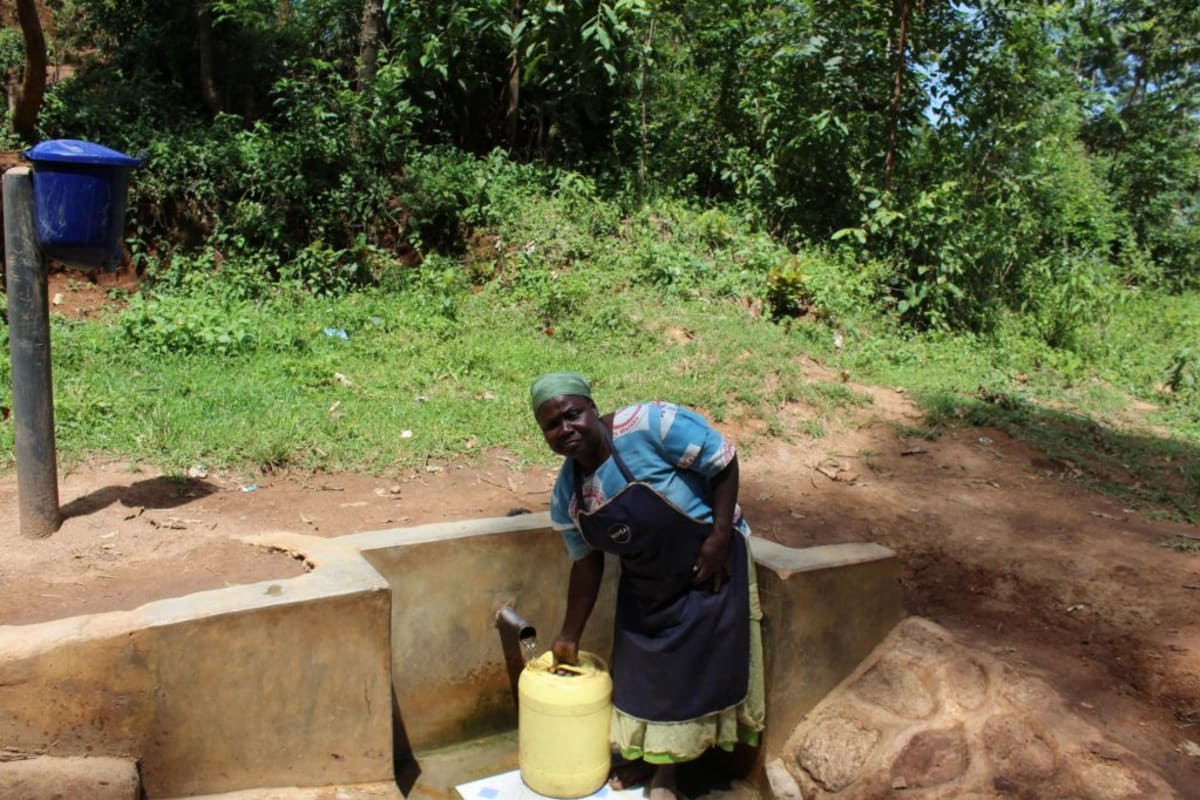A normal day in Wasenje starts with people getting up early in the morning to get lots of work done on their farms before the sun gets too high in the sky. Many people engage in farming cash crops like bananas, while the women also manage smaller kitchen gardens that produce vegetables for their own families' meals.
Water
About 250 different households rely on Margaret Jumba Spring to meet all of their water needs. It's used for cooking, cleaning, and drinking. When it doesn't rain, farmers get their irrigation water from Margaret Jumba Spring. There are also four nearby schools that use the spring's water throughout the school day.
Wasenje's people were thrilled to see us visit their spring. They told us it's served them for years, but nobody was ever willing to help them protect it from contamination. Green algae is visible on the water's surface, and it's so murky you can't even see the bottom. Waterborne disease has been a part of life in Wasenje ever since its establishment. People, especially the children, suffer from typhoid.
Sanitation
Most households have a pit latrine, but after observing some of these, we've decided that we need to teach community members how to build safer latrines. A lot of these have dangerous floors that are built from logs. This wood is almost impossible to clean and rots away - putting the user at risk of falling through into the pit.
A handful of households have a hand-washing station nearby the latrine, but there's no soap. We toured Margaret Jumba's home, and she told us a bit about standards in the rest of her community.
"Though we have mosquito nets, some of us use them to fence vegetables... as if our mosquitoes no longer bite people, but vegetables," she said.
It's not uncommon to see that people already have the tools they need to prevent sickness, but they just don't use them right.
Here's what we're going to do about it:
Training
Community members will attend hygiene and sanitation training for at least two days. This training will ensure participants have the knowledge they need about healthy practices and their importance. The facilitator plans to use PHAST (Participatory Hygiene and Sanitation Transformation), CLTS (Community-Led Total Sanitation), ABCD (Asset-Based Community Development), group discussions, handouts, and demonstrations at the spring. One of the most important topics we plan to cover is the handling, storage, and treatment of water. Having a clean water source will be extremely helpful, but it is useless if water gets contaminated by the time it’s consumed. Hand-washing will also be a big topic.
Training will also result in the formation of a committee that will oversee operations and maintenance at the spring. They will enforce proper behavior around the spring and delegate tasks that will help preserve the site, such as building a fence and digging proper drainage. The fence will keep out destructive animals, and the drainage will keep the area’s mosquito population at a minimum.
Sanitation Platforms
On the final day of training, participants will select five families that should benefit from new latrine floors.
Training will also inform the community and selected families on what they need to contribute to make this project a success. They must mobilize locally available materials, such as bricks, clean sand, hardcore, and ballast. The five families chosen for sanitation platforms must prepare by sinking a pit for the sanitation platforms to be placed over. All community members must work together to make sure that accommodations and food are always provided for the work teams.
Spring Protection
Protecting the spring will ensure that the water is safe, adequate and secure. Construction will keep surface runoff and other contaminants out of the water. With the community’s high involvement in the process, there should be a good sense of responsibility and ownership for the new clean water source.
Fetching water is predominantly a female role, done by both women and young girls. Protecting the spring and offering training and support will therefore help empower the female members of the community by giving them more time and efforts to engage and invest in income-generating activities.
This project is a part of our shared program with Western Water And Sanitation Forum (WEWASAFO). Our team is pleased to provide the reports for this project (formatted and edited for readability) thanks to the hard work of our friends in Kenya.

 Protected Spring
Protected Spring
 Rehabilitation Project
Rehabilitation Project

































